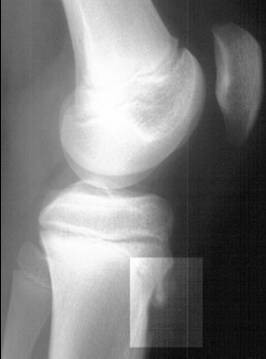- Osgood-Schlatter disease
Infobox_Disease
Name = Osgood-Schlatter disease
Caption = Lateral radiograph of the knee demonstrating fragmentation of the tibial tubercle (see inset) with overlying soft tissue swelling.
DiseasesDB = 9299
ICD10 = ICD10|M|92|5|m|91
ICD9 = ICD9|732.4
ICDO =
OMIM =
MedlinePlus = 001258
eMedicineSubj = emerg
eMedicineTopic = 347
eMedicine_mult =eMedicine2|orthoped|426 eMedicine2|radio|491 eMedicine2|sports|89
MeshID =Osgood-Schlatter disease (also known as tibial tubercle apophyseal traction injury) is an inflammation of the growth plate at the
tibial tuberosity , and is one of a group of conditions collectively called osteochondroses. The condition is named after the American surgeon Robert Bayley Osgood (1873–1956) and the Swiss surgeon Carl Schlatter (1864–1934), who independently described the disease in 1903. [cite journal | author= Osgood R.B. | title=Lesions of the tibia tubercle occurring during adolescence | journal=Boston Medical and Surgical Journal | year=1903 | volume=148 | pages=114–7] [cite journal | author= Schlatter C. | title=Verletzungen des schnabelförmigen Forsatzes der oberen Tibiaepiphyse | journal= [Bruns] Beiträge zur klinischen Chirurgie | year=1903 | volume=38 | pages=874–87] cite journal |author=Nowinski RJ, Mehlman CT |title=Hyphenated history: Osgood-Schlatter disease |journal=Am J. Orthop. |volume=27 |issue=8 |pages=584–5 |year=1998 |pmid=9732084 |doi=]The disease is most common in active boys and girls aged 11-15cite journal |author=Yashar A, Loder RT, Hensinger RN |title=Determination of skeletal age in children with Osgood-Schlatter disease by using radiographs of the knee |journal=J Pediatr Orthop |volume=15 |issue=3 |pages=298–301 |year=1995 |pmid=7790482 |doi=] and is usually self-limiting.
Causes
The condition is caused by stress on the patellar tendon that attaches the quadriceps muscle at the front of the
thigh to the tibial tuberosity. Following an adolescent growth spurt, repeated stress from contraction of thequadriceps is transmitted through the patellar tendon to the immature tibial tuberosity. This can cause multiple subacuteavulsion fracture s along with inflammation of the tendon, leading to excess bone growth in the tuberosity and producing a visible lump.ymptoms
Pain and swelling directly over the tibial tubercle is most common. Point tenderness is noted on examination.
Pain is aggravated by loaded knee extension activity, especially activity with power or impact characteristics. Symptoms may occur with
activities of daily living (ADLs) such as walking and using stairs.The symptoms usually resolve with treatment but may recur as a new episodes until skeletal maturity, when the tibial epiphysis fuses.
Treatment
Diagnosis is made clinically,cite journal |author=Cassas KJ, Cassettari-Wayhs A |title=Childhood and adolescent sports-related overuse injuries |journal=Am Fam Physician |volume=73 |issue=6 |pages=1014–22 |year=2006 |pmid=16570735 |doi=] and treatment is conservative with rest and simple pain reduction measures of ice packs and if required
paracetamol (acetaminophen) oribuprofen . The condition usually resolves in a few months, with a study of young athletes revealing a requirement of complete training cessation for 3 months (on average) and gradual resumption of full training by 7 months.cite journal |author=Kujala UM, Kvist M, Heinonen O |title=Osgood-Schlatter's disease in adolescent athletes. Retrospective study of incidence and duration |journal=Am J Sports Med |volume=13 |issue=4 |pages=236–41 |year=1985 |pmid=4025675 |doi=10.1177/036354658501300404]Bracing or use of plaster of paris to enforce joint immobilization is rarely required and does not necessarily give quicker resolution.cite journal |author=Engel A, Windhager R |title= [Importance of the ossicle and therapy of Osgood-Schlatter disease] |language=German |journal=Sportverletz Sportschaden |volume=1 |issue=2 |pages=100–8 |year=1987 |pmid=3508010 |doi=] Surgical excision may rarely be required in skeletally mature patients.cite journal |author=Gholve PA, Scher DM, Khakharia S, Widmann RF, Green DW |title=Osgood Schlatter syndrome |journal=Curr. Opin. Pediatr. |volume=19 |issue=1 |pages=44–50 |year=2007 |pmid=17224661 |doi=10.1097/MOP.0b013e328013dbea]
After symptoms have resolved, a gradual progression to the desired activity level may begin. In addition, predisposing factors should be evaluated and addressed. Commonly
quadriceps and/orhamstring tightness is present and should be addressed with stretching exercises. Training factors such as intensity and repetition should also be evaluated and addressed.
=AdditionalReferences
Wikimedia Foundation. 2010.

